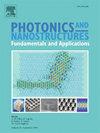Molecular structure, linear, and third-order nonlinear optical treatment of GO@ZnFe2O4/TMSP/CdTe QDs nanocomposite: Preparation and characterization
IF 2.9
3区 物理与天体物理
Q3 MATERIALS SCIENCE, MULTIDISCIPLINARY
Photonics and Nanostructures-Fundamentals and Applications
Pub Date : 2025-07-22
DOI:10.1016/j.photonics.2025.101431
引用次数: 0
Abstract
This study reports the synthesis and characterization of a novel GO@ZnFe₂O₄/TMSP/CdTe nanocomposite with enhanced third-order nonlinear optical (NLO) properties. The nanocomposite was synthesized via a solvothermal method and structurally characterized using Xray diffraction (XRD), Fourier Transform Infrared (FTIR), field emission scanning electron microscopy (FESEM), energy dispersive X-ray (EDX), and ultraviolet-visible (UV–Vis) spectroscopy. XRD analysis confirmed the successful formation of the composite phases with good crystallinity, while FTIR spectra revealed strong chemical bonding between the constituents. FESEM images showed a uniform morphology and intimate contact among the components. Magnetic measurements indicated a superparamagnetic behavior with moderate saturation magnetization, confirming the preservation of ZnFe₂O₄ magnetic properties within the hybrid structure. The complex dielectric function was derived using Kramers–Kronig (KK) analysis of FTIR reflectance spectra, revealing prominent LO and TO phonon modes. NLO measurements were performed using the continuous-wave (CW) Z-scan technique at 532 nm. The nanocomposite demonstrated reverse saturable absorption (RSA) and a negative nonlinear refractive index (), with self-defocusing effect. Importantly, the nonlinear coefficients were found to increase with increasing nanocomposite concentration, confirming the role of particle density in enhancing the NLO response. These findings indicate strong light-matter interactions and thermal contributions under CW excitation. Comparative analysis with reported materials shows that the synthesized nanocomposite exhibits competitive NLO performance. The material's multifunctionality and strong optical nonlinearity suggest promising applications in optical limiting, photonic switching, and magneto-optical devices.
GO@ZnFe2O4/TMSP/CdTe量子点纳米复合材料的分子结构、线性和三阶非线性光学处理:制备和表征
本文报道了一种新型的GO@ZnFe₂O₄/TMSP/CdTe纳米复合材料的合成和表征,该复合材料具有增强的三阶非线性光学(NLO)性能。采用溶剂热法合成了纳米复合材料,并利用x射线衍射(XRD)、傅里叶变换红外(FTIR)、场发射扫描电子显微镜(FESEM)、能量色散x射线(EDX)和紫外可见(UV-Vis)光谱对其进行了结构表征。XRD分析证实了复合相的成功形成,具有良好的结晶度,而FTIR光谱显示了组分之间的强化学键合。FESEM图像显示各组分形态均匀,接触密切。磁测量表明,在中等饱和磁化强度下具有超顺磁性,证实了ZnFe₂O₄在杂化结构中保留了磁性。利用FTIR反射光谱的KK - kronig (Kramers-Kronig)分析推导出复介电函数,揭示出明显的LO和TO声子模式。NLO测量使用连续波(CW) z扫描技术在532 nm处进行。该纳米复合材料具有反向饱和吸收(RSA)和负非线性折射率(n2),具有自散焦效果。重要的是,非线性系数随着纳米复合材料浓度的增加而增加,证实了粒子密度在增强NLO响应中的作用。这些发现表明,在连续波激发下,光与物质之间存在强烈的相互作用和热贡献。与已有材料的对比分析表明,合成的纳米复合材料具有具有竞争力的NLO性能。该材料的多功能性和强光学非线性在光限制、光子开关和磁光器件方面具有广阔的应用前景。
本文章由计算机程序翻译,如有差异,请以英文原文为准。
求助全文
约1分钟内获得全文
求助全文
来源期刊
CiteScore
5.00
自引率
3.70%
发文量
77
审稿时长
62 days
期刊介绍:
This journal establishes a dedicated channel for physicists, material scientists, chemists, engineers and computer scientists who are interested in photonics and nanostructures, and especially in research related to photonic crystals, photonic band gaps and metamaterials. The Journal sheds light on the latest developments in this growing field of science that will see the emergence of faster telecommunications and ultimately computers that use light instead of electrons to connect components.

 求助内容:
求助内容: 应助结果提醒方式:
应助结果提醒方式:


